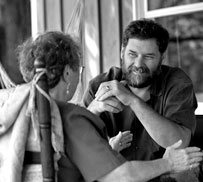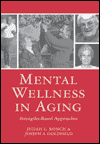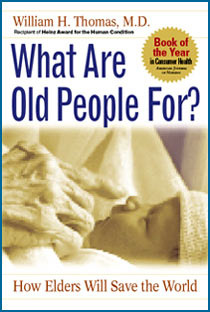![]()
Search
Recent Posts
- BIZZARO news headline
- Bob Ball, Dead at 93
- Ronni tells it like is
- The Genius of Aging Campaign
- Bizzaro!
- Hey Doc, tell us how you REALLY feel...
- Green Co-Housing
- Role of the Next Generation of Culture Change Advocates
- Preventing the Epidemic of Falls
- Must Watch, Must Share, Must Act Now
- Red Beer... an Acquired Taste?
- No Country for Old Women
- Power Up Friday: Young at Heart Edition
- Newshour Video
- A Place Where Love Matters
Recent Comments
- Bill Benson on
Blanchard WinsDays - Monkhouse Christa on
Kevin Frick writes... - Al Power on
Kevin Frick writes... - Peg Boyles on
Kevin Frick writes... - Christa Monkhouse on
Blanchard WinsDays - Imee on
Understanding Health Care Reform - Nick on
Understanding Health Care Reform - Steve Skrlac on
Too Old to Ditch a Plane? - Bonnie on
More on Age and Airline Pilots - Joe Podson on
Better Care for Seniors
Category Archives
- AGING 100
- Aging
- Culture
- Dementia
- Eden Alternative
- Erickson School
- Green House
- Health Policy
- Longevity
- Media
- Rockets
Monthly Archives
- February 2009
- January 2009
- December 2008
- November 2008
- October 2008
- September 2008
- August 2008
- July 2008
- June 2008
- May 2008
- April 2008
- March 2008
- February 2008
- January 2008
- December 2007
- November 2007
- October 2007
- September 2007
- August 2007
 Subscribe to this blog's feed
Subscribe to this blog's feed
Announcements

Blog Data
January 2008 Archives
January 2, 2008
Athens, Sparta and Old Age
The paragraph below is an abstract from an article by Chris Gilleard. Th abstract and full citation can be found here.
This paper examines attitudes toward old age in classical Greek literature to reflect upon contemporary debates about anti-aging. The Greek habit of dividing the world into mutually exclusive categories was a hallmark of their culture. One such division, between youth and old age, formed a persistent theme in Greek myth, poetry and theatre. Youth — neotas — was sweet, beautiful and heroic. To leave youth meant one quickly passed the threshold to old age — geras. Old age was ugly, mean and tragic. There was no middle ground, no third age. Sparta, the city state least inclined toward literature, litigation, art and trade provides an instructive contrast. Here an unchanging politics engendered an unending respect for those older than oneself. This was institutionalized in the powers of the Gerousia or Council of Elders. The implications of these differing perspectives are considered in the light of our contemporary ambivalence toward aging and anti-aging.
I find it interesting that Athens, which was inclined toward Art, Music and Politics maintained a dismissive attitude toward old age. Sparta, in contrast, was famous for its war-like spirit and yet was able to maintain an honored place at the heart of its society for older--- men. About older Spartan women we know little.
Greek...
Neotas-- youth
Geras--- old age
English...
The care of new born babies--- neonatalogy
The care of older people-- geriatrics
Here is where Mt. Google earns his keep.

Posted by Dr. Bill Thomas on January 2, 2008 10:21 AM |Permalink |Comments (0)
Jib Jab Does 2007
A good way to tell if you were paying attention.
Posted by Dr. Bill Thomas on January 2, 2008 11:42 AM |Permalink |Comments (0)
January 3, 2008
Things Change: And That's OK
John Dawson is one of the founders of "The New Riders of the Purple Sage."
Here he is in Central Park...

Here he is in Albuquerque...

Posted by Dr. Bill Thomas on January 3, 2008 6:19 AM |Permalink |Comments (0)
Dorothea Says It Better
One sign of high intelligence is the ability to present the essence of complicated ideas in a simple understandable way. Like this...
From the Comments,
This final rule by the EEOC is definitely a step backwards when it comes to addressing the fiscal challenges that our federal government faces as it continues to support entitlement programs that benefit older adults. First, the rule promotes private corporations dumping their liabilities on the public sector. Secondly, it does nothing to address the need to create a policy that encouarges older people to remain in the work force longer.
I say, let's elect Dorothea to Congress!
Posted by Dr. Bill Thomas on January 3, 2008 2:01 PM |Permalink |Comments (0)
Feel The Excitement
Later this month, Judah Ronch and I are co-teaching (along with a stellar guest faculty) a terrific course on collaborative approaches to long-term care...
CREATING COLLABORATIVE CULTURES IN SENIORS HOUSING & CARE: A PRACTICAL APPROACH
JANUARY 15-18, 2008
Judah Ronch, Ph.D., Professor, The Erickson School and
William H. Thomas, M.D., Professor, The Erickson School and Founder of The Eden Alternative and the Green House
Consumers drive change in our society, and the senior housing and care sector is becoming increasingly responsive to consumer demands. In the past, organizations could concentrate on the fundamentals of finance and operations and expect to flourish. Now, consumers (along with regulators, advocates and family members) want more. A person-centered organizational culture increasingly defines the core of success in this emerging market. Formerly "soft" goals like "dignity," "respect," "autonomy" and "meaning" are moving to center stage. How can leaders balance the new emphasis on "person-directed" cultures with the equally pressing need for effective management of capital and human resources?
Leading approaches to developing person-centered organizational cultures will be examined, including the strengths and weaknesses of each. Companies representing different person-centered approaches will share their real-world experiences. In addition to industry representatives, guests will include government officials from the Centers for Medicaid and Medicare Services, who will address regulatory issues, and author Beth Baker.
For more information, call Melissa Roane at 443-543-5646, email melissa4r@umbc.edu, or visit http://erickson.umbc.edu/.
Posted by Dr. Bill Thomas on January 3, 2008 3:46 PM |Permalink |Comments (0)
January 4, 2008
The Savvy Boomer Likes...
Here is the Savvy Boomer's take on the new movie, "The Bucket List."
I definitely recommend stopping by the blog, it's a great fusion of techno-generational savvy and news you can use.
I watched the new movie, The Bucket List, last night. I won't give you any spoilers but I'm sure you know how a flick about 2 guys dying from cancer is going to turn out eventually. The story is somewhat contrived as it is about 2 men who would never associate in their normal lives, that are brought together in a hospital by their common denominator of cancer. One of them is mega-rich and finances their no-limits last fling at life comprised of a list they made of things to do before they kick the bucket. Nicholson and Freeman are 2 pros that could hold your attention watching grass grow so needless to say, their performances live up to expectations.I get the feeling that "Bucket List" is going to become one of those coined phrases like "at the end of the day" that you are going to hear people using over and over. I think most of us have a kind of mental bucket list that we started thinking about when we reached a birthday that had a zero in it. After all, every time we change a decade, there are a number of stereotyped variables that go along with that decade. I think I started my mental bucket list when I hit 40 but I keep modifying it as I age. That's not necessarily because I have completed some items on the list but because as my values change, some things lose importance and others gain.

Posted by Dr. Bill Thomas on January 4, 2008 6:47 AM |Permalink |Comments (0)
Comment Authorization
(Note from webmaster Kavan)
Attention all Changing Aging readers!
After waging an unsuccessful war to keep the comments section open to all comers, I am admitting defeat to Hillary Duff, Paris Hilton and the legions of porn spammers overwhelming our comments section with links to FREE NUDE PHOTOS. I can't keep them out while letting you post freely, and I'm getting bored deleting all that junk.
So starting today, ChangingAging.org will only accept comments from readers authorized by Typekey, a free authentication service that blocks spammers.
I apologize for the inconvenience. Please alert me directly (email me at kavanATumbcDOTedu) if you encounter problems registering with TypeKey or are opposed in any way to this type of authentication service.
And remember...

Posted by Kavan Peterson on January 4, 2008 12:26 PM |Permalink |Comments (2)
Power Up Friday: At the Movies
Al Power is a distinguished geriatrician and an expert in the field of dementia. He went to see "The Savages" and files this report with ChangingAging...
For New Year's Eve, I took sort of a "busman's holiday" and went to see a movie about dementia and nursing homes. "The Savages" is the story of a brother and sister who are not very close, but must come together to care for their estranged father after he is diagnosed with dementia. I recommend it highly.
What they got right:
- the anguish that family members feel, complicated by unresolved issues from past relationships.
- the utilitarian way most of us are forced to choose long-term care. (Wendy: What's the nursing home like? Is it nice?" John: "They take Medicaid, they're near my house and they have an opening.")
- they really capture the trappings of the institutional nursing home, from the decor and the nursing stations to the small shared rooms, flimsy curtains and the fluorescent light that glares in the elder's eyes.
- my favorite image was the rather robotic and meaningless act of pulling the Thanksgiving turkey off the bulletin board and stapling up the Christmas Santa face.
- they also showed that the majority of people who work in these homes are good, caring people who try to know their elders and give them back some dignity in such surroundings. Philip Seymour Hoffman, Laura Linney and Philip Bosco and the rest of the cast are superb at simply being so "real" in their roles.
My only beef - they mis-diagnosed the dad as having Parkinson's disease, which rarely causes dementia early on. Bosco's portrayal was fairly classic Lewy body dementia, and he did it beautifully.
My favorite line: Wendy calls John at 1 AM in hysterics after getting a voice mail about their father: Wendy: "He's sick! He's somewhere out West, we don't know where! We have to go and find him!" John (half-asleep and perturbed): "Wendy, this isn't a Sam Shepard play. We don't have to go and find him."

Posted by Dr. Bill Thomas on January 4, 2008 3:18 PM |Permalink |Comments (1)
January 6, 2008
Lewy Body
This is the best site on the topic of Lewy Body Dementia.
Posted by Dr. Bill Thomas on January 6, 2008 2:06 PM |Permalink |Comments (0)
January 7, 2008
In What Year Was This Man Born?
How old was he in---- say 1970?

Posted by Dr. Bill Thomas on January 7, 2008 5:03 AM |Permalink |Comments (1)
The Boomer Bash
[Editor's Note] Below is a post from the latest issue of Age Beat Online (ABO), an e-newsletter for the Journalists Exchange on Aging, which is an excellent network supported by the American Society on Aging. This post is longer than usual, but all our Baby Boomer readers will appreciate ABO Editor Paul Kleyman's rant.
NPR AND THE EDDIE HASKELL FACTOR: Remember Eddie Haskell, Wally’s selfish and conniving buddy on “Leave It to Beaver”? Nobody liked that phony. One would think that at least some in today’s national media would equate the boomer generation more with the Beav: bright, open, curious. But the boomer bashing that continues in mainstream media -- some of it purposeful attacks from those wishing to slash entitlement programs for elders, but much of it gratuitous -- seems to frame the boomers as the Eddie Haskell of generations. RODNEY DANGERFIELD got more respect.

(Eddie Haskell, The Beaver and Wally)
A case in point is JOHN YDSTIE’S piece on NPR’s “Morning Edition” this Wednesday (Jan. 2) titled “Baby Boomers Begin to Claim Social Security”. Ydstie, a usually fine reporter and fill-in anchor, starts, “America’s baby boomers have always thought they were special.” Later, “The culture of their youth still lingers in the air.” (That’s the “they’ll never grow up” cliché that’s become so prevalent.) Later still, “Baby boomers have always lived in denial of growing old. Age 62 is the new 50, right? Except that now you are eligible for a Social Security check.” And in discussing the small size of Gen X, which will yield a demolished workforce charged with covering Social Security’s ongoing costs, Ydstie opines, “Of course, that’s the baby boomers’ fault. They had fewer children.” Funny, this boomer remembers being told -- especially by Paul Erlich, a member of the older Silent Generation -- that having too many babies was irresponsible and would set off “The Population Bomb.”
What’s odd about Ydstie’s piece is that these smarmy asides were unnecessary. In a 7½ minute piece, a major story for broadcast, he gets most of his overview of Social Security right. Ydstie does fall into the usual trap of citing the shrinking ratio of workers to pay for the retirement of the aging boomers, a figure widely quoted but almost always misused, but he does not go on, as so many have, to declare that Social Security will be bankrupt and is in crisis. These outright fabrications were fed to the public through a largely unskeptical Washington press corps that had been cultivated by conservative think tanks since the early 1980s. Now it’s refreshing to see other sources cited to balance such claims.
Ydstie includes quotes by the venerable liberal economist HENRY AARON of the Brookings Institution and conservative ALAN VIARD of the American Enterprise Institute both agreeing that Social Security does not warrant, as Aaron put it, “a hysterical sense of urgency” and that Medicare is in a much more precarious financial state. (Ydstie didn’t quite get to the larger concern that Medicare and Medicaid are in trouble because of wider healthcare inflation, but his report is an improvement on past reporting.) At least on the issue of the shrinking fertility rate he didn’t cite rightist economists who have said -- I kid you not -- that young women today should show their patriotism by having more babies, unlike their irresponsible, bra-burning mothers of the ‘60s and ‘70s.
So, what’s with the nasty slams, the pseudo-psycho profiling of the selfish boomers? Is it just too cute to pass up a two-buck chuckle and doesn’t really seem to hurt anyone? Problem is that these kinds of group slurs are expressions of -- dare I say it -- prejudice. ABO has cited more vicious examples, notably Christopher Buckley’s novel “Boomsday,” a laugh-filled promotion of the idea that boomers will drain our children’s future -- and should have an assisted-suicide option for those presumed noble enough not to collect Social Security benefits.
I guess one shouldn’t expect too much originality around national newsrooms, but there is an alternative view: that an older population in which both men and women are healthier, well educated and widely experienced can be a boon to society. Ydstie does note that a longer-working population of elders can do much to close the current projections of Social Security’s 75-year shortfall. But reporters might also talk to someone like THEODORE ROSZAK, author of the 2002 book “Longevity Revolution: When Boomers Become Elders” (Berkeley Books). The historian, whose 1968 classic “The Making of a Counter Culture” added that coinage to the language, posits that older societies have always been wiser, kinder and gentler. There are others we could mention (Bob Butler for one) who can argue pretty convincingly that widespread longevity is not such a bad thing. Or reporters could note that most of the economic problems attributed to spendthrift, “me-generation” boomers have to do with poor management of the national economy. A couple of wars, some tax cuts for the rich, a subprime mortgage debacle, failure to control healthcare costs for the rich, and pretty soon you’re talking about a real crisis. Oh-oh.
But what about this seeming urge to psychologize about the alleged profligacy of an entire generation as if it were one character -- named Eddie Haskell. Even TOM BROWKAW has indulged in some of this couch-jockeying in recent interviews about his new book, “Boom: Voices of the Sixties” (New York City: Random House, 2007.) The characterization seems to spread through news copy like a virus.
A few real facts can be said about the boomer generation in the United States:
* At around 78 million, they are the biggest generation in history.
* The GI bill gave them better-educated parents and a large middle class, so they grew up with a higher standard of living than ever before.
* Universal compulsory education, still only a few decades old by 1946, accelerated after World War II for both boys and girls.
* The pill.
* The diversity of the boomers presents an enormous demographic range for analysis.
* Boomers have more living parents than any previous middle-aged population in history.
* And boomers have the benefit of the longevity revolution in science, technology and social organization.
I’m sure ABO readers can think of a few other incontrovertible and consequential facts. In the meantime, though, I can assure Mr. Ydstie that 62 is the new 62. And that’s something worth celebrating: some aches and pains aside—not something to complain about.
By the way, for a well-balanced treatment of Social Security, see “Fears of Social Security’s Collapse Unfounded, Experts Say,” by BOB MOOS in the Dallas Morning News (Dec. 11, 2007).
Reprinted with permission from Age Beat Online, e-news of the Journalists Exchange on Aging, www.asaging.org/agebeat, copyright JEOA 2007
Posted by Kavan Peterson on January 7, 2008 1:24 PM |Permalink |Comments (0)
TGB Rock's this Week in Elder News
New must-read feature by Ronni Bennett at TGB:
[EDITORIAL NOTE: Today we inaugurate a new feature at TGB that will appear each Saturday - links to news items from the preceding week relating to elders and aging, along with whatever else catches my fancy that I think you might like to know about. Suggestions are welcome.]
Catch-up here -- This Week in Elder News.
Posted by Kavan Peterson on January 7, 2008 3:55 PM |Permalink |Comments (1)
New Hampshire
I am very excited about the NH primary.
Hope you are too.
May the best candidates win...
Posted by Dr. Bill Thomas on January 7, 2008 6:05 PM |Permalink |Comments (0)
January 8, 2008
You Do It Too.
Posted by Dr. Bill Thomas on January 8, 2008 6:27 AM |Permalink |Comments (0)
Comment Update
[Note from Webmaster] Hey folks -- we're getting some negative feedback regarding signing-in to comment. We're going to allow open commenting again, but only comments from registered users will publish automatically. There may be a delay for nonregistered comments but we'll try to post them as quickly as possible. Thanks for the feedback!
Posted by Kavan Peterson on January 8, 2008 9:34 AM |Permalink |Comments (2)
Is It An Emergency?
I've been concerned about the kind of care that people of all ages but especially older people get in American Emergency rooms.
Turns out I'm not the only one...
Is There A Crisis in Emergency Medicine?
Q. Is there a crisis in the nation’s emergency departments?A. Yes. Emergency department visits in 2003 rose to 114 million, up from 89.8 million in 1992. At the same time, the number of emergency departments decreased by 15 percent, resulting in dramatic increases in patient volumes and waiting times at the remaining facilities.
Q. What is the impact of overcrowding on patient care?A. According to the U.S. General Accounting Office, overcrowding causes prolonged pain and suffering for patients, long emergency department waits, and increased transport times for ambulance patients.
Q. What is causing the crisis?A. A lack of hospital inpatient beds; a shortage of on-call medical specialists; an increasing elderly population; and nationwide shortages of nurses, physicians, and support staff.
Q. Why do hospitals "board" inpatients in the emergency department?A. Hospitals are not always able to meet the demand for inpatient beds for emergency patients because of financial pressures. This can lead to waits of hours or days for an available inpatient bed
Q. What are the solutions?A. the United States must make a national commitment and recognize that emergency medicine is an essential community service that must be funded.
Q. Can the problem be solved by educating people not to use the emergency department for minor medical problems?A. No. Most patients who seek hospital emergency care are very sick or would be by the time they could see a primary care doctor. Only 10 percent of emergency department visits in 2002 were classified as non-urgent.
I am interested in stories from and about older people who encounter the American Emergency Medical System...

Posted by Dr. Bill Thomas on January 8, 2008 10:05 AM |Permalink |Comments (1)
January 9, 2008
Age Changes Us All
Plenty of people are aware of, think about and talk about religious, ethnic, and racial diversity in American society.
Scott E. Page, a professor of complex systems, political science and economics at the University of Michigan, is suggesting that diversity is one of the mainsprings of productivity in the business world. NY Times article here.
I'm good with that but what bothers me is that the VALUE of aging as a source of diversity is routinely discounted.
The myth is that "all old people are alike."
Not.
My hero, T. Franklin Williams tells doctors in training...

"When you've seen one old person, you've seen one old person..."
In other words, age is the most distinctive, diverse, part of the entire life cycle.
Put another way...
Infants are the group of people in America who are the most like each other. Despite what their mothers might believe, any given newborn is very very like all other newborns.
People in their 80's, however, are very very different from each other.
So if diversity is good and contributes in a healthy way to the overall diversity of our society...
We need to make sure that a diversity of ages is a part of the mix.
This is why I am generally opposed to the standard and unthinking practice of segregating older people from people of other generations.
Posted by Dr. Bill Thomas on January 9, 2008 5:41 AM |Permalink |Comments (2)
January 10, 2008
Embodied Aging: Gets the Call
Embodied Aging shares the people, images and ideas which add meaning and joy to my life. Thanks for visiting. ~ Sharry Teague
Here is a taste...
At Costco I flipped through The Daring Book for Girls parked right there beside The Dangerous Book for Boys. These books are all about knowing how to do stuff - using a compass, sewing on buttons - things like that. They invite kids to an acoustic life. Hands on. And they must have got me thinking.I made the SoulCollage card (pictured below) just before the Winter Solstice. It’s entitled The Call. "Called to what?" I’ve wondered. This morning I woke with the sense that I was called to a year of living dangerously*, but I doubt I’ll be heading off to Indonesia. I think my dangerous life includes a component described in the books above, a willingness to engage with life, not as a consumer, but as a learner, with all the floundering and failure learning implies.
Failure makes me very nervous. I was never angrier with my sister, Barrie, than when she entered a swim meet at The Club and came in dead last. Buying a book and reading it is safe. Working on a project that matters could be a real mess. A friend once hurt my feelings. I told him I was scared to write, and he said, “You are afraid to find out you aren’t as good as you think you are.” Blunt, maybe, but accurate.
So I’m ready to live dangerously. Just being myself (in whatever floundering way that can happen). Risking that I will be accepted and loved anyway. Risking that wobbling and a few falls are worth it to learn to write a story or bake bread or whatever else Life calls me to. The Velveteen Rabbit had it right, being Real is not for sissies.

Posted by Dr. Bill Thomas on January 10, 2008 5:12 AM |Permalink |Comments (0)
January 11, 2008
How Circuit City...

Committed Suicide
This is from Prospect.org's Beat the Press, summarizing this piece from the Washington Post:
The basic story is that last March, the wise men who run Circuit City came up with the brilliant idea of laying off their more senior salespeople, who get $14-$15 an hour, and replacing them with new hires who get around $9 an hour. It turns out that this move was not very good for business. One of the reasons that people go to a store like Circuit City, rather than buying things on the Internet, is that they want to be able to talk to a knowledgeable salesperson. Since Circuit City had laid off their knowledgeable salespeople, there was little reason to shop there. ... The Post reports that Circuit City's executive vice-presidents will get retention awards of $1 million each.The good news is that this will now kill the company, preventing it from happening again; the bad news is that these executives will probably get new jobs at a new company instead of being rousted from their beds by out-of-work salespeople and perforated by pitchfork.
There is a nice bit of satire on the subject here.
Personally I would like to believe that this debacle will dissuade other employers from confusing age with burden.
I doubt it though.
Posted by Dr. Bill Thomas on January 11, 2008 6:57 AM |Permalink |Comments (0)
Which Witch Again?
Some ChangingAging readers remember when I went on a witch rampage a couple of months ago.
See here, and here and here...
Well I now confess that I omitted the key historical document which (smile) explains the whole fear of witches thing fully, responsibly and with the utmost accuracy.
Enjoy...
Posted by Dr. Bill Thomas on January 11, 2008 2:54 PM |Permalink |Comments (0)
Like Medieval Peasants, Boomers Will Demand Choices
[Guest post from Kavan at UMBC]
That last post about witches was silly, absolutely silly. I'd like to elevate the discourse on this blog with a real discussion about age, ageism, sexism, classism, feudalism, communism, marxism, imperialism and anarchocommunalsyndicalism.
Posted by Kavan Peterson on January 11, 2008 3:22 PM |Permalink |Comments (0)
January 13, 2008
The Number One Movie in the Land?
Cancer comedy "Bucket List" rules movie box office...
Comedies mining the unlikely topics of terminal cancer and a church robbery led the North American box office on Sunday, sending ticket sales higher for a fifth consecutive weekend.
"The Bucket List," starring Jack Nicholson and Morgan Freeman as patients boldly facing their demise, sold $19.5 million worth of tickets during the three days beginning on Friday. The Warner Bros. release, which had played in New York, Los Angeles and Toronto the prior two weekends, drew an older audience, the Time Warner Inc-owned studio said.
Gotta admit, I did not see that coming. But I do like the fact that the top movie appeals to GROWN-UPS...
Posted by Dr. Bill Thomas on January 13, 2008 7:10 PM |Permalink |Comments (0)
January 14, 2008
Good Eden Story
Here is an nice example of change that is moving in the right direction.
The tell-tale sign that this is Mary Deffner's home might be the Christmas cookie flour sprinkled across her purple sweater. It might also be the grandmotherly look she gives the children dancing in front of her, or the caged finches chirping behind her..The 73-year-old Beacon Ridge nursing home resident doesn't view her future at the home as a death sentence. She may be living out her later years with 120 or so other old souls needing daily assistance, but she's also among live plants, colorful murals, wandering animals, friendly staff and regular visitors from the day care center next door.
"It seems trite to say it, but it's like a family here. I'm very comfortable," says Ms. Deffner, a former nurse from Shaler, who uses a wheelchair and who posed as horror movie villain Freddy Krueger to entertain the children at a Halloween party this year.
The facility, which embraces the modern "Eden Alternative" vision of nursing home care, shows how the industry is trying to shed its longtime, negative image. Occasional horror stories of blatant neglect and more frequent tales of frustrating mediocrity, by way of unanswered call lights and undiagnosed maladies, have created a sense of dread across the country for many families faced with a first-time nursing home admission.
A set of positive signs in Pennsylvania indicates the need for such fears may be diminished
Read the whole thing here...
Posted by Dr. Bill Thomas on January 14, 2008 6:23 AM |Permalink |Comments (1)
Cheney-Care
Ronni Bennett has an excellent post on health care policy that is worth a read.

My favorite part...
An important financial aspect of a successful universal healthcare plan is including everyone in the pool. The 80/20 rule of business applies to healthcare; about 20 percent of the population uses 80 percent of healthcare. By spreading the cost – through taxes, premiums, subsidies where necessary, etc. – everyone contributes and everyone, rich and poor alike, has equal access to healthcare.If the 80 percent of healthier people object to financing the 20 percent, they would do well to keep in mind that each of us is only one disease or accident away from joining the 20 percent. And if the wealthy want to purchase additional coverage for luxury hospital rooms and monkey-gland treatments at spas in Switzerland, fine. But healthcare is a human right and the time has come for the United States to join the rest of the industrialized nations in granting that right.
Contrary to conventional wisdom, the U.S. does not have the best healthcare in the world. It lags far behind every other industrialized nation in the standard benchmarks of national health including life expectancy and infant mortality, and those other nations achieve their superiority at a much lower cost per person than the United States.
Posted by Dr. Bill Thomas on January 14, 2008 11:24 AM |Permalink |Comments (2)
January 15, 2008
No Miracle Pill
Giving Alzheimer's drugs to people with early memory problems does not seem to delay the onset of the disease, researchers said on Tuesday.Three main drugs — Aricept, or donepezil; Exelon, or rivastigmine; and Reminyl, or galantamine — are currently approved for use in mild-to-moderate Alzheimer's disease.They are also often prescribed on a so-called "off-label" basis to people with pre-dementia.
But doctors are divided over their effectiveness, leading to differing rates of use and bitter arguments over patient access to treatment, notably in Britain where a dispute over their cost-effectiveness has led to legal clashes.
I have taken care of many people who were living with dementia. Their loved ones were uniformly in favor of and even desperate in their search for something that could change the course of the disease. I was always under pressure (all doctors are) to prescribe these drugs. The pressure comes from other doctors (peer pressure if you will) , family members, patients themselves and most especially from the drug companies that make these products.
The problem is that, outside of a small number of exceptional circumstances, the drugs listed above are largely ineffective and expose patients to substantial and sometimes dangerous side effects.
Having said that, I guess I can forget about Big Pharma sending me a nice fat check!
Posted by Dr. Bill Thomas on January 15, 2008 6:20 AM |Permalink |Comments (2)
Courts Run Amok
This should be Banned in Boson
Dawn Cromwell dares not leave her building. If she tried, a device girding her ankle would sound an alarm. For over a year, she has had to use store-bought reading glasses because her pleas for a prescription pair have gone for naught. She is given medications, but, she says, no one will tell her what they are. more stories like thisFor 20 months now, Cromwell's life has been defined by a 10.5-by-12.5-foot living space at North End Rehabilitation and Nursing Center. In her tiny closet, there are virtually no clothes, and she has no idea what's become of the cherished possessions in the Boylston Street apartment where she lived for years.
At 73, Cromwell is one of hundreds of forgotten docket numbers in Massachusetts probate and family courts, where judges routinely fast-track infirm elders into the care of guardians, often with little evidence to justify such wrenching decisions.
Cromwell, after a broken ankle and a brief rehab in early 2006, had expected to go home. But on the say-so from the nursing home's doctor - a short, nearly illegible diagnosis - a judge decreed that Cromwell was mentally ill and handed all of her decision-making to a guardian. Cromwell lost all power over her own life, with no opportunity to object, no right to have a lawyer represent her, no chance to even be in the courtroom.
Three months later, the same judge, E. Chouteau Merrill, made the guardianship permanent - in a two-minute hearing in which the judge asked not a single question.
"You think living in America is just great, but you never anticipate something like this," Cromwell said. "It's just been a disaster for me. If I was robbed on the street and everything taken, I wouldn't be as upset as I am now."
This is a failure of our culture.
Posted by Dr. Bill Thomas on January 15, 2008 4:07 PM |Permalink |Comments (0)
January 16, 2008
Guppie Mania!!!!!
I stop by to see the folks at www.fightingaging.org every now and then. It's always interesting to see what they are up to...
Here is a fairly typical entry drawn from the site's archives.
My comments are in bold...
Biology is diversity; while the rule on predation and the evolution of longevity seems to hold for most species, there are always outliers: "mice are low on the food chain and rather likely to meet a bad end; consequently, there’s very little opportunity for genes that enhance longevity to benefit the animal (or even get expressed in the first place). Based on examples of this kind, biologists of aging generally predict that lower extrinsic mortality from predation is a positive influence on the evolution of longevity.
These sentences could benefit from being re-written. The meaning I take from them is:
a) The science of biology is varied and complex and offers many opportunities to stretch unrelated findings to buttress favorite pre-conceived notions.
b) Species which are subjected to intense pressure from predators tend to sacrifice traits associated with longevity in favor of traits that help them hide from, run from or defeat their predators.
c) This explains, for example, why their are no retirement homes for aged mice.
Hence, it is surprising that guppies exposed to predation actually appear to live longer (and age more slowly) than similar fish from a similar environment without predators. ... This is an exception to two classical predictions of evolutionary theory: that low extrinsic mortality should be associated with longer life span, and that higher fertility should be associated with shorter life span.
When I read a statement like this, the first thoughts that pop into my mind are, "Where's the evidence? What is the proof? How can I be sure that what the writer is claiming is actually true?" In particular, I would like to see a link to the article on guppie longevity. That would let me read the article and decide, for myself, whether I agree that: "guppies exposed to predation actually appear to live longer (and age more slowly) than similar fish from a similar environment without predators." I did find the article in question and you can read it here. Without going into details it seems that what the authors of the article are actually claiming is that guppies exposed to predators develop a survival strategy that relies on relatively higher losses (to predators) of young guppies and greater survival among older guppies.
Some theorists have tried to accommodate this and other anomalous results within the standard framework, but we argue that the exceptions they carve out do not explain the results at hand. In fact, the findings suggest that population regulation has been selected at the group level, though this is a mechanism that most theorists regard with suspicion."
Extra-ordinary claims require extra-ordinary proof. Changes in guppie populations are interesting but are not enough to overthrow one of the bedrock principles of modern biology:
Selection pressure is applied at the level of the individual, not the group.
For what it's worth, this paragraph comes closer to capturing the real issues at hand.
Why do bats live longer than comparably sized and metabolically similar rodents? One idea is that chiropterans can escape predation more easily (because they can usually, though not always, fly away), thereby decreasing one major source of extrinsic mortality and exposing later life to selection pressure. In contrast, mice are low on the food chain and rather likely to meet a bad end; consequently, there’s very little opportunity for genes that enhance longevity to benefit the animal (or even get expressed in the first place). Based on examples of this kind, biologists of aging generally predict that lower extrinsic mortality from predation is a positive influence on the evolution of longevity.
The peculiar longevity of human is derived partly, but not completely from our position atop the world's food chain....
Posted by Dr. Bill Thomas on January 16, 2008 6:43 AM |Permalink |Comments (0)
Let's Not Forget About...
Reverse Ageism
Posted by Dr. Bill Thomas on January 16, 2008 11:45 AM |Permalink |Comments (0)
Elders – Boon or Burden?
[Guest post by Kavan from UMBC]
In my years tracking state government news as a reporter for Stateline.org, I saw a lot of doom and gloom stories like this gem from the Cincinnati Enquirer:
Study: Aging Ohioans putting strain on economyCOLUMBUS -- Ohio's aging population is going to put a backbreaking strain on the state's economy, property-tax base, health-care and retirement systems starting in 2012, according to a study released last week.
“Backbreaking”? Sounds like Ohio has a pretty serious problem… OLD PEOPLE… here are the numbers:
Today, Ohio experiences a daily net increase of 14 people age 65 or older. By 2012, that number grows to 119 new retirees per day.
The publisher of the report goes on to call Ohio’s aging population a ”disaster for state and local budgets, with no obvious solution.”
Well, that’s one way to look at our elder-rich future. And I won’t argue with the numbers. For the first time ever in a handful of states, healthcare is supplanting education as the largest chunk of the budget. And we know most healthcare spending goes towards caring for people in the final years or months of their lives. Nationally, America's official debt is over $9 trillion, and our primary social safety nets for older adults -- Social Security and Medicare -- face unfunded liabilities upwards of $40.9 trillion. Locally, nationally and globally, we face some pretty significant public policy challenges in terms of adapting to our rapidly expanding population of elders. Duh. Nobody is arguing with that.
But that is no excuse for the hysterical tenor of most news coverage about the "Silver Tsunamai" waiting to wipe out our economic future. I don't care how scary the demographic projections are, there is no excuse for painting the entire over-65-demographic as a bunch of freeloading leeches poised to suck our economy dry.
In fact, some folks are making a case that there is actual VALUE -- social, economic, spiritual, etc. -- to be gained by welcoming elders with open arms.
Take Colorado for instance -- Boomers blogger Brent Green explains here:
Our state is going to beat your state.What I mean by this is simply a promise that Colorado will be doggedly persistent in transforming the aging of the Boomer generation into a strategic focus and an economic opportunity. Many states are talking about it; few are taking substantive action.
[snip]
After two years of planning and generous contributions of time, resources and energy, Colorado introduced last November its strategic vision called Silverprint Colorado. Our goal is straightforward:
Colorado will establish a culture for positive aging addressing the needs, contributions and opportunities for all its older residents.Certainly this vision addresses our intentions to provide quality care and assistance to older Coloradoans late in life. But it’s also a revelation about economic opportunities.
As I discussed in my keynote address, Colorado has exceptional prospects to capitalize on aging in the areas of tourism, housing, spirituality, healthcare, biotechnology, the arts, the green movement, and education, to name a few.
[snip]
Colorado has a mile-high vision for aging; we have broad-based support; and we have an entrepreneurial drive that’s endemic of the new west.If you live elsewhere and I’ve stimulated your competitive instincts to challenge Colorado's preeminence as the nation’s most hospitable state for Boomers and pre-Boomers, then, frankly, we all win.
I say let the competition begin. Click the logo to learn more.

Posted by Kavan Peterson on January 16, 2008 7:09 PM |Permalink |Comments (3)
January 17, 2008
Age and the Work Force...
Go to Hollywood

Documentary filmmaker Patricia Sahertian has spent the past year researching, networking with and filming people affected by ageism in the work force. When this first started she had no idea of the number of wonderful and open people she would come in contact with, who would be willing to share their stories and make their voices heard. There also have been the connections with the many organizations that are trying to make a difference, who open their doors everyday to help the older worker. This revelation has been an emotional experience giving her the determination to communicate what she has learned. Now she is in production with the film, organizing her footage and starting the editing process."I have met some amazing, resilient, intelligent people who are proud of their accomplishments. It is mind boggling to me that they are unemployed or underemployed. They have so much to offer," asserts Sahertian.
In this effort to make a difference and challenge stereotypes Sahertian says “There are so many people I want to thank, from those who have agreed to be in the documentary, to the ones who have helped behind the scenes, making contacts, telling their friends and colleagues about Fight Ageism.”
Posted by Dr. Bill Thomas on January 17, 2008 11:54 AM |Permalink |Comments (0)
January 18, 2008
It Never Stops
Never to be forgotten, never ever, to be forgotten is the sad truth that the burden of ageism in our society falls most heavily on women, women young and old alike.
Amanda Hinsperger covers the issue effectively in
this article.
What is it about anti-aging? It seems truly ironic that our society feels and projects such negativity about aging.
Young women spend a fair chunk of their time trying to look older than they really are and baby boomers are reaching their senior years, so why is our culture obsessed with youth?
Women in particular carry the anti-aging burden, since most anti-aging ads are marketed to women. Are we afraid of aging? Does the natural course of life disturb us? Nobody likes to admit their body is failing. With all the stress this worrying brings on, and with the aging impacts of stress, maybe we'd be doing ourselves a favour by embracing age.
All you have to do is turn on the television to be bombarded by ads for a cream or lotion, a hair product, a cosmetic or an outpatient procedure designed to make people, usually women, look younger. Even in ads not obviously related to health and beauty, there is still an underlying theme of youth as desirable. All anti-aging advertisements and products reinforce the social belief that aging is bad and increase the pressure to fight aging, particularly for women.
There is more and it is very good. By the way, Amanda Hinsperger is 24 years old.
Posted by Dr. Bill Thomas on January 18, 2008 6:30 AM |Permalink |Comments (0)
January 19, 2008
Tap Tap Five Minutes
Posted by Dr. Bill Thomas on January 19, 2008 6:40 AM |Permalink |Comments (0)
January 21, 2008
Marketing Over Science
Out here in the real world, researchers understand that so-called negative results can be just as helpful as positive results.
For example, a positive result can look like this:
Drug X is more effective than a sugar pill when it comes to treating the symptoms of major depression.
A negative result, in contrast, might read like this:
Drug Y is no more effective than a sugar pill when it comes to treating the symptoms of depression.
For a scientist, both results are important and useful.
Because marketing and science are two very different things, companies which are interested in maximizing sales are likely to emphasize positive results while attempting to bury negative results.
It turns out that is exactly what is happening.
The makers of antidepressants like Prozac and Paxil never published the results of about a third of the drug trials that they conducted to win government approval, misleading doctors and consumers about the drugs’ true effectiveness, a new analysis has found.In published trials, about 60 percent of people taking the drugs report significant relief from depression, compared with roughly 40 percent of those on placebo pills. But when the less positive, unpublished trials are included, the advantage shrinks: the drugs outperform placebos, but by a modest margin, concludes the new report, which appears Thursday in The New England Journal of Medicine.
Previous research had found a similar bias toward reporting positive results for a variety of medications; and many researchers have questioned the reported effectiveness of antidepressants. But the new analysis, reviewing data from 74 trials involving 12 drugs, is the most thorough to date. And it documents a large difference: while 94 percent of the positive studies found their way into print, just 14 percent of those with disappointing or uncertain results did.
Some people believe that the market and market mechanisms are the key to solving our shared health care crisis.
I disagree.
A market system has powerful built in incentives which value sales over science. If we have learned one thing over the past century it is that the careful, skillful and unbiased application of science to the problem of human disease and suffering is powerfully effective.
This powerful historic insight is undermined whenever and wherever marketing is given dominion over the unbiased application of clinical research.
Posted by Dr. Bill Thomas on January 21, 2008 6:22 AM |Permalink |Comments (1)
More on Marketing Over Medicine
Saw this article this morning and thought it might compliment the post below...
When a Duluth-based operator of hospitals and clinics purged the pens, notepads, coffee mugs and other promotional trinkets drug companies had given its doctors overThe operator, SMDC Health System, intends to ship the 18,718 items to the west African nation of Cameroon.
The purge underscored SMDC's decision to join the growing movement to ban gifts to doctors from drug companies.
SMDC scoured its four hospitals and 17 clinics across northeastern Minnesota and northwestern Wisconsin for clipboards, clocks, mouse pads, stuffed animals and other items decorated with logos for such drugs as Nexium, Vytorin and Lipitor.
Trinkets, free samples, free food and drinks, free trips and other gifts have pervaded the medical profession, but observers say that's starting to change.
"We just decided for a lot of reasons we didn't want to do that any longer," Dr. Kenneth Irons, chief of community clinics for SMDC, said Friday.
By the way, the image above comes from John Mack's Pharma Marketing Blog.
John offers readers an incredible insider's view of the drug industry's unquenchable thirst for sales. I highly recommend it. Plus he's got great images.
Posted by Dr. Bill Thomas on January 21, 2008 10:42 AM |Permalink |Comments (0)
Comment of the Week
If it takes two to tango, it takes a few more to get a real community dialog flowing. Below is the Changing Aging post-of-the-week from Dorothea in response to Cheney-Care. Dorothea didn't just comment, she told us how it is. Folks, this topic is worth a few more comments.
Personally, I am very pessimistic that we will ever create a national health care system in this country. I don't understand this paradox - Americans are extremely charitable and giving people. This is evident by the number of volunteer organizations, numerous charitable causes, and the daily stories of heroic efforts by individual people who would give the shirt off their back to help others in need.Yet, when it comes to the notion of getting together as a nation to formulate a plan that provides a basic human right to health care for all, we are at each others' throats in conflict. Do we really think that we are that invincible? That our pitiful middle class wages are sufficient to help us in a health crisis? Do we really think that by moving into the suburbs, placing our kids in a private school, and holding two jobs to pay for it, that we can "protect" ourselves from the rest of the nation's problems?
There is something inherently wrong with our collective consciousness and sensibility when we fail to see that this is not just a moral issue but an economic one as well. And that it affects all of us, no matter how hard we try to hide and avoid it.
One of the morning shows on NPR ran a segment yesterday talking about the national fury that a leak to the German press caused last week. You see, the citizens there are angry about a recent disclosure of the salaries of car maker Porsche's Management Board. The German nation was outraged to learn that the average take home pay for a CEO of their top 30 publicly traded companies is $6 million.
The average director in Germany makes about 8 times the salary of a skilled worker. In our country, this ratio is 200. Germans think of this as a moral outrage where as we consider it to be a positive value of the entrepreneurial spirit.
Similarly, our strong sense of individualism and self-reliance (certainly values with a lot of merit) has blinded us to the fact that, at the very core, we are completely dependent on each other for survival. Whether we see this or not, it's true.
--Dorothea Johnson
Posted by Kavan Peterson on January 21, 2008 1:16 PM |Permalink |Comments (1)
January 22, 2008
The Healing Power of Dogs
The Eden Alternative has known this (and so have many other people) for a long, long time. Still, it is nice to see scientific proof!
Dogs have long had special standing in the medical world. Trained to see for the blind, hear for the deaf and move for the immobilized, dogs have become indispensable companions for people with disabilities.But dogs appear to be far more than four-legged health care workers. Over the years, data on the larger role dogs play in health has trickled out from various corners of the world. One Japanese study found pet owners made 30 percent fewer visits to doctors. A Melbourne study of 6,000 people showed that owners of dogs and other pets had lower cholesterol, blood pressure and heart attack risk compared with people who didn’t have pets. Obviously, the better health of pet owners could be explained by a variety of factors, but many experts believe companion animals improve health at least in part by lowering stress.
Dogs, in particular, also have been shown to do remarkable things to improve the health of their owners. There are stories of dogs warning their owners of imminent health threats. In 2003, University of Florida researchers published a report in the journal Seizure noting that some dogs seem to have an innate ability to detect impending seizures. A 2000 report in the British Medical Journal examined case studies of dogs alerting people with diabetes of a coming hypoglycemic episode.
More recently, some studies have suggested dogs can be cancer detectors. In 2006, the medical journal Integrative Cancer Therapies reported how ordinary house dogs could identify breast and lung cancer patients by smelling their breath. A University of Maine study is testing whether dogs can sniff out ovarian cancer.
The role dogs play in medicine is celebrated in a new book, “Paws & Effect: The Healing Power of Dogs’’ (Alyson Books, 2007), which chronicles the numerous ways dogs contribute to our health. Author Sharon Sakson is a journalist and television producer, dog breeder and American Kennel Club dog-show judge. She admits to being biased about her subject matter, and she tends to write about the mundane details of dogs and their owners. Much of the evidence surrounding dogs and health is anecdotal, although Ms. Sakson includes many references to published research. The stories of service dogs are particularly impressive, as is the nascent research into dogs’ ability to detect cancer.

Posted by Dr. Bill Thomas on January 22, 2008 5:41 AM |Permalink |Comments (2)
January 23, 2008
The Jerusalem Post Gets It
Reader Alex M passes along this gem by Helly Paz...
Jan. 20, 2008
"One of the things that characterizes old people is that they keep talking about what they used to be before they retired," says Pnina Sulzbacher, director-general of the Nofei Yerushalayim assisted living facility in Jerusalem's Bayit Vegan neighborhood.
Here, Sulzbacher says proudly, "each resident uses his or her skills to contribute to and further shape the community they live in, and holds a position that helps run this unique home."
Beyond offering residents the opportunity to grow old with dignity, Nofei Yerushalayim is a place for those who want to continue to play an active role in their community.
The building, which served as a hotel in the early 1980s, contains some 200 one- to three-bedroom apartments, all of which are occupied. Only 10 professional employees work there, as opposed to at least 40 in regular assisted living facilities. This is possible because the residents of Nofei Yerushalayim continue exercising their professional skills after retirement. One resident is in charge of preparing and serving the food in the cafeteria, another gives art classes, and others give enrichment lectures.
Every four years, the house's tenants elect a new chairman of the organization, and all of them vote on the house's budget once a year, as per the regimen of available classes, recreation and services the house funds.
Former Knesset member Tamar Eshel, 87 - who also served as an adviser to former Jerusalem mayor Teddy Kollek and as Israel's envoy to the UN in charge of the Committee for Women's Rights - is one of the three founders of Nofei Yerushalayim. At first, she says, the home - which has been registered as a nonprofit organization since 1989 - was not self-sufficient.
"We didn't like the fact that there was an authority above us, so we established a new company called Nofei Yerushalayim, and we decided to create a place that would be... highly accessible to the typical Jerusalemite."
Eshel's co-founders were Eliyahu Lankin and Pinhas Pino Ginzburg, who were once on opposite sides of the fence in Israel's early years. Lankin was a Revisionist, a Zionist activist, an Irgun Etzel member and a politician who commanded the Altalena cargo ship that the IDF bombed in June 1948; Ginzburg was a Hagana member who was on the shores of Tel Aviv and commanded the attack on the Altalena. Forty-one years later, the two joined together with Eshel to build a house for senior citizens who still had control of their faculties.
"Most tenants are... not businessmen, but people with average incomes," says Eshel. "We were strict on the self-managing aspect, even though we didn't know much about it. Shortly after establishing the place, we started visiting similar organizations and comparing services. We wanted to build a community that would supply all the tenants' needs and desires," Eshel recalls.
There is always a waiting list of at least 50 people, and the lucky ones who eventually get an apartment can design it themselves with the home's two interior designers.
Each new tenant must deposit a check for $160,000 - the cost of an average apartment - which is returned to the heirs if the tenant passes away. All residents pay a monthly fee of around NIS 4,100, which covers all facilities - including medical and cultural services - except for phone service and food. The facility does have a dining room, however, and the meals are served at a fair price.
The facility boasts a gym, a pool, a billiard hall, a supermarket, two libraries, on-call medical staff and a variety of enrichment courses given in two languages - Hebrew and English - since many of the tenants are native English speakers.
The place also keeps four apartments for tenants' relatives, who can stay over for NIS 90 per night.
Most residents are busier than they were before retiring, and besides volunteering in organizations like Yad Sarah and Nofei Yerushalayim's geriatric department, they go to the theater, put on their own presentations, read and generally enjoy a satisfying standard of living.
Aba Gefen, a former Foreign Ministry official, and his wife Frida chose to bring their furniture and lifestyle into Nofei Yerushalayim. Gefen is currently the house's chairman and writes articles in Yiddish for a New Yorker outlet, while Frida is a member of the house's welcoming board, which approves new tenants, and of the house's appearance committee.
"We have realized that age has no meaning here and a person can be part of this community as long as he [or she] can call this place his or her home," says Frida. "The youngest tenant is 69 years old, and he still goes to work every day, and the oldest is 96, and she is still very vital and contributes."
"This house has succeeded," says Eshel, "but one can never know what will happen in the next 20 years."
A great change has occurred in the market of assisted living facilities, and today people have different expectations when they move to a protected residence. Besides, this market has become business-oriented, and ultimately it's all about the investor's revenue and not the residents' satisfaction."
Posted by Dr. Bill Thomas on January 23, 2008 6:44 AM |Permalink |Comments (0)
To Gray Or Not To Gray
The twin driving impulses of age, at least from my point of view, are...
Choice
and
Influence
It is the combination of choice and a growing capacity to influence that opens the door to life beyond adulthood.
Therefore, I take no position on what color men or women young or old should make their hair. Hair color is not a predictive marker of wisdom, influence or worth.

This young woman has gray hair and, it seems from this photograph, is at peace with her appearance. We should all be so fortunate.
The Health and Life Mixing Bowl has more...
Whether or not women should go gray is a hot issue these days. Time magazine has a great article that compares the gray hair wars with the "stay at home with the kids" vs. "go to work" debate. The article shows two pictures of Condaleeza Rice, one with gray hair, one with black hair. I'll let you be the judge. Included are remarks from the hair dye king, Clairol, who states that their role is to help women create an authentic connection between how she feels internally versus how she looks externally. Hmmm....So they get to decide what your hair color says about how you feel? The article's most controversial quote came from Rose Weitz, author of Rapunzel's Daughters: "What Woman's Hair Tells Us About Women's Lives". She quotes, "Even if, in the abstract, we think we look all right with gray hair, we nonetheless feel as if we are losing our 'real selves' if we no longer have our 'real hair color' - the color we had when we were young and looked our best." Feeling as if we are losing our 'real selves'? As if hair dye is real? If anything is real it's the stigma attached to going gray. It took me forever to find a picture of a healthy, attractive woman with gray hair. Type in "gray hair women" in a photo search engine and you'll come up with tons of frail and sickly looking women sitting in wheelchairs and nursing homes. Where are the vivacious gray-haired mamas? I know you are out there! After searching a bit I finally found the picture above. This woman went gray when she was 13 and decided to leave her hair natural. I think she is beautiful.
Posted by Dr. Bill Thomas on January 23, 2008 6:47 AM |Permalink |Comments (4)
'Green House' Communities Reinvent Elder Care
[Editor's Note: I'm still hoping the Newshour will post the full video of this report on Dr. Bill Thomas' Green House project -- you really have to see inside the Green Houses to fully comprehend how radical of a departure and improvement this is over institutionalized care -- it's mindblowing. Below are excerpts from the transcript and links to the full report.]
(Courtesy of the Newshour on PBS)
Susan Dentzer, health correspondent for the Newshour on PBS, filed this report on Dr. Bill Thomas' "Green House" project, which seeks to reinvent traditional nursing home care and create close-knit communities of patients and caregivers:
SUSAN DENTZER: Dr. Bill Thomas was already one of the nation's most outspoken nursing home reformers when we first interviewed him six years ago.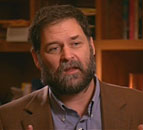
DR. BILL THOMAS (Geriatrician and Nursing Home Reformer): What you're seeing right now is the end of the American nursing home. It is finished. And the big question that really ought to be on the lips of the politicians, and the leaders, and the academics is: What comes next?
SUSAN DENTZER: At that time, Thomas had started down the road to the next phase, with something called the Eden Alternative. The approach revamped the nursing home in various ways, most visibly with plenty of green plants and even animals.
What Thomas came up with next was what he called "Green Houses," small, homelike settings where care for elders, rather than the demands of the institution, came first.
DR. BILL THOMAS: This house really, for me, is a dream come true.
SUSAN DENTZER: Today, that vision is a reality, here at this Green House in Lincoln, Nebraska. It's operated by Tabitha Health Services, a Lutheran-affiliated nonprofit focused on long-term care.
DR. BILL THOMAS: Hi, I'm Dr. Thomas.
SUSAN DENTZER: When Thomas visited for the first time recently, he talked with Eva Goldsby, one of nine residents here. She told him that the Green House feels much more like home than Tabitha's other traditional nursing home.
EVA GOLDSBY (ph),Resident, Tabitha: This is a lovely place to be at.
DR. BILL THOMAS: Why is it different than the big house?
EVA GOLDSBY: Well, it's just like being at home.
SUSAN DENTZER: At times, in fact, the Green House seems more like a clubhouse for seniors than a skilled long-term care facility. Two afternoons a week, for instance, there's happy hour.
DR. BILL THOMAS: What do you like to have at happy hour?
EVA GOLDSBY: Beer, usually.
DR. BILL THOMAS: Beer? Yes, I think I'll join you.
EVA GOLDSBY: Yes, red beer, sometimes.
DR. BILL THOMAS: Oh, red beer?
EVA GOLDSBY: Yes, do you like that?
DR. BILL THOMAS: I've never tried it.
EVA GOLDSBY: Oh, just tomato juice in beer.
DR. BILL THOMAS: Oh, whoa!
SUSAN DENTZER: There are now 35 Green Houses up and running on 13 campuses across the country. In partnership with a nonprofit, NCB Capital Impact, the Robert Wood Johnson Foundation is spending nearly $10 million to replicate the model nationwide.
Click here to listen.
Click here to read the entire transcript.
Click here for more information on the Green House project.
Posted by Kavan Peterson on January 23, 2008 5:31 PM |Permalink |Comments (0)
January 24, 2008
More on the Hair Question
Here is another take on the hair color question...
From The Ugly Earring
i’ve made the decision not to dye my gray hair. as a result, they’re coming in like wild dandelions, reckless and noticeable. originally, i thought i’d wake one morning to find all my gray hair lying flat in one dense area, making a lovely emmy lou harris streak…not so much. almost a year has passed since the first dozen appeared, and the grays are everywhere lacking order and restraint.i recently bought a box of temporary hair color in what would later be known as a borderline relapse. I was feeling too young to go gray. After all, i’m in my early 30s and having these rowdy strands sticking up and in random places can look frumpy, messy and simply blah.
but i couldn’t do it. (have i grown attached to them already?) if i began the battle, i would surely lose…the task of dying, redying and hiding. i quickly realized it just isn’t worth it. i’m supposed to go gray whether i like it or not.
so i’d like to think i’m currently going through one of those awkward growth spurts (much like junior high) that one must pass before they enter the gates of womanhood or, better yet, before they are granted a head full of white hair.
By the way, I am starting to go gray and liking it so far.
I am 48 and I am a man so the issues I face are very different from the ones which women must confront.
Going Gray is a delightful blog that really dives into the question...
Posted by Dr. Bill Thomas on January 24, 2008 6:57 AM |Permalink |Comments (0)
A Place Where Love Matters
Editor's Note: Thanks to Providence Women for this post on Dr. Thomas' Newshour appearance:
Did you see the Lehrer News Hour this evening, January 23, with the story about transformative nursing homes? Dr. Bill Thomas, geriatrician and nursing home reformer was interviewed in one of his “Green House” nursing homes in Lincoln, Nebraska.
The twelve-minute story highlights two primary characteristics of the Green House concept – characteristics of all transformative nursing homes. The first, making the nursing home HOME, with all the implications that follow. The residents interviewed testify to that. So do the front line workers in a more indirect but compelling way. From the transcript:
Ebmeier, Nursing Home Administrator, and the shahbazim, (plural for shahbaz, name for traditional certified nurse assistants), tell the story of one former Green House elder, Mary Valentine, who celebrated her 101st birthday in the Green House.
JOYCE EBMEIER, Administrator: One of the shahbazim went to her and said, "Well, Mary, what do you want to do? What shall we do so that you have a great birthday?" And she looked at the shahbaz and she said, "You know, what I really want is a margarita and a cigarette."SUSAN DENTZER, Narrator: And that's what she got, as seen in this picture, taken as she and her daughter celebrated on the Green House's front porch. When Valentine died soon after that memorable day, the shahbazim were crushed. They told us that was the downside of life in the Green House, saying goodbye.
THOMAS COOPER, Shabaz: The night after she had passed, my dog (note the place of animals in this setting) went into her room, and jumped up on her recliner, and sat where Mary used to sit. That was really emotional for me, and for the whole group of shahbazim, and the whole team.
JOYCE EBMEIER, Administrator: Death gets harder in a Green House because, when you are smaller and when you are engaged in the way that the shahbazim are engaged in the lives of the elders they love so much, it is like losing your dearest family member.
The video shows a hanging plaque which reads: “In memory of Mary Valentine. May her spirit protect, nurture and sustain all who enter here.”
DR. BILL THOMAS: In long-term care, love matters. And the heart of the problem is institutions can't love.
snip...
The story from Lincoln, Nebraska is heartening. There are not enough of these HOMES yet. We MUST liberate our elders from traditional nursing home and bring them HOME.
Click here to continue reading A Place Where Love Matters.
Click here to watch the streaming video.
Posted by Kavan Peterson on January 24, 2008 8:06 AM |Permalink |Comments (0)
Newshour Video
Streaming video of the Newshour report on the Green House project can now be viewed online -- click here.
Posted by Kavan Peterson on January 24, 2008 11:54 AM |Permalink |Comments (1)
January 25, 2008
Power Up Friday: Young at Heart Edition
Woo hoo! I've been waiting for this to come out!! The release date is April 18th.
Here is the trailer for the movie Young At Heart
See you at the movies...
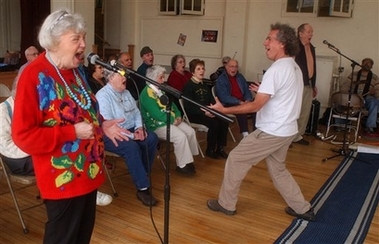
Posted by Dr. Bill Thomas on January 25, 2008 6:59 AM |Permalink |Comments (0)
No Country for Old Women
Here is a case in point on the relative burden of ageism in our
society. I have taken an article from here and changed the gender. See what you think...
The old women of film are going through a growth spurt. Now their maturity is lending much more weight to movies. By Marsha Feeney‘Age will flatten a woman,” Elizabeth Hurley says in No Country for Old
Women and she’s right, it will. It can also deepen, strengthen and
enrich her. One look at Hurley in No Country — or in In the Valley of
Elah — and you see demonstrated the power of age to bring up, as well
as wear down.Hurley is 61 now and in those movies the weight of every minute of her
time on earth seems recorded on her face. A moonscape of seams, crags
and creases. Even more than that bark of a voice, that face is what
lends Hurley her enormous onscreen authority.But it’s not just Hurley who is using her age as a formidable weapon
in her acting arsenal — “60 is the new 40,” say the glib publicists.We have seen the female stars showing their age but still strutting
their stuff. Meg Ryan, 71, did a fine job of acting in and directing
Lions for Lambs. Julia Roberts, 70, created a unique sense of magic in
Mr. Magorium’s Wonder Emporium.At 70, Kirsten Dunst is busier than she was when she was 30.
It’s hard to imagine a star who better demonstrates the improvement
age can bring than Dunst.She’s just completed a new movie, The Changeling, and the music she
wrote for Grace is Gone is picking up award nominations.With each movie, the lines on Dunst's face have been etched more
deeply in an accelerated paring away of youthful prettiness into
something noble.Time has eroded her, yes, but to the same sublime effect as a desert
canyon.
I am guessing it will be a while before we see this sort of thing in
reality.

Posted by Dr. Bill Thomas on January 25, 2008 10:56 AM |Permalink |Comments (1)
Red Beer... an Acquired Taste?
More blog praise for the Newshour's special report on the Green House project:
I watch the Lehrer Newshour most night to unwind. By 8pm, I've eaten, cleaned up, and ready to sit on the couch for a while. Last night, the Newshour featured a new concept in nursing homes: the Green House. The idea came from a doctor in Nebraska who had worked in the elder care sector, and seen ways he thought he could improve the model. He has turned the institutional care facility that we are familiar with into a open-plan home. The home is built for about 12 to 15 elders each, and is tailored to their needs, rather than the needs of the institution. My favourite feature: twice weekly happy hours.
Thanks Rob, me too -- who doesn't love happy hour? Although after drinking Red Beer with Eva Goldsby, I still prefer my beer straight up. Also, Nebraska's a great state, but this doctor hails from upstate New York. And I'll correct you on one important note -- a critical part of the Green House model requires the household be limited to nine to 12 elders. The model cannot sustain an adequate level of care and community over that limit.
BlogHer
Virginia Debolt posted this video from YouTube showing what a Green House looks like and how the elders who live there react to the living arrangements:
Thanks also to Providence Women and Home Life News blogging about the Newshour story.
Click here to watch the Newshour segment.
Click here for more information on the Green House project.
Posted by Dr. Bill Thomas on January 25, 2008 11:11 AM |Permalink |Comments (2)
January 27, 2008
Must Watch, Must Share, Must Act Now
The Daily Kos today features a story on Annie Leanard's The Story of Stuff, a 20-minute online video that is, as Daily Kos puts it, "as direct, effective, and eye-opening on consumer society as An Inconvenient Truth is on climate change." 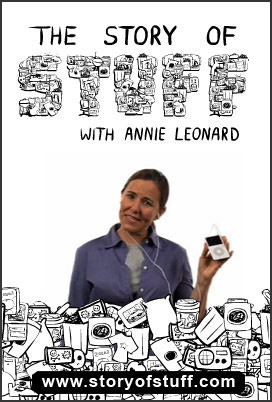 If you haven't seen it, stop reading and click on this image. NOW. Seriously. Go watch it.
If you haven't seen it, stop reading and click on this image. NOW. Seriously. Go watch it.
And here's the story behind The Story of Stuff.
Annie Leonard's The Story of Stuff by DevilstowerFor a year, Annie Leonard was part of a varied group of activists who met to polish their leadership skills. Month after month, despite her best efforts, she could tell that she wasn't getting through to the other participants. Five minutes into her talk on "changing the paradigm of our materials relationship," eyes were glazing over. It was Eli Pariser of moveon.org who finally gave her the insight she needed. "I have no idea what you just said," he told her. "I work on democracy, and all I know is that democracy doesn't have anything to do with 'materials.'"
But Annie knew that democracy had everything to do with materials. At the next meeting, she was back with a set of simple drawings on posterboard, and she was back with a new phrase. Instead of materials, she was there to talk about "stuff" -- all the stuff we eat, wear, use, throw out, burn, and bury. Instead of documenting the flow of resources through consumer society, she was telling The Story of Stuff.
With the help of producer Louis Fox and artist Ruben DeLuna at Free Range Studios, Annie turned her one hour talk into a twenty minute film. A film that's been watched by more than one million unique viewers. A film that's available on line and which you can watch by clicking the picture above. If you haven't seen the film go now. Seriously. Right now. You'll be glad you did. Because this short film is as direct, effective, and eye-opening on consumer society as An Inconvenient Truth is on climate change.
Though the original presentation was aimed at exciting activists, the short film is snappy enough to catch the attention of people who've never involved themselves in progressive causes. In the same day, Annie has received fan mail from American fourth graders and from Oxford dons. The simple graphics and enthusiastic narration of the film allow everyone to find themselves among the stick figures on screen. The appeal is so universal that the most frequent request Annie receives is to translate the Story of Stuff into other languages. At last count, there were more than 200 such requests, along with a book version in the works.
While Annie is thrilled at the attention The Story of Stuff has received so far, getting people to watch the film is just a small step toward a goal that may be tougher than landing a man on the moon: breaking the grip of the shop/consume/dispose culture and replacing it with a system that's sustainable.
While the problems of consumer culture have spread worldwide, America holds a unique place in the scheme that Annie dates back to decisions that we made at the outset of the Industrial Revolution. In some countries, people chose to take advantage of increasing productivity to reduce the work week, to take more vacations, and enjoy more time with family and friends. But in America, every gain was turned into a material gain, into more stuff. Rather than gathering in more happiness and freedom from advancing technology, we buried ourselves in an ever accelerating quest for the latest goodies. Generation by generation, year by year, we've accumulated more goods and consumed more of the world's resources (and made ourselves more miserable).
It's a problem that's perpetuated today by everything from the way we're entertained to the way we're educated. Where once we practiced "keeping up with the Joneses" by comparing ourselves to our neighbors, television has provided a window on consumer paradise where part-time baristas own huge Manhattan apartments and office workers dress in the latest designer duds. We're no longer happy to compare our possessions with the couple down the street, we have to compete with Brad and Angelina. We don't want what our friends have, or what our parents had, we want what Oprah has. This "vertical expansion of the reference group" means we can never reach our goals and are always left feeling as if we've failed. The only solution to our inadequacy? Go shopping for more stuff!
Shopping has become the key to how we view ourselves to such an extent that not only did George W. Bush urge us to shop ourselves out of the peril of 9/11, even environmental activists often turn to the mall. What's the most frequent advice dispensed to people trying to behave more responsibly? Buy green. It's advice that not only encourages still more consumption as means to address the problem of over-consumption, but it all too often ignores the market forces that have delivered "green" products to the local mall -- forces that rarely have any concern for the resources or people damaged along the way.
As we worry about the current economic downturn, even the way we attempt to measure our problems reflects this distorted shopaholic culture. Take a primal forest, kick out the people who have lived there for generations, cut down the trees, slice them into pieces, soak them in toxic chemicals, turn them into disposable products, and ship the discarded remains off to a landfill. On the business page of your local paper or the glitzy stock channel on your television, each of those steps has the same name: growth. What's a recession? Lack of growth. How do we end a recession? Stimulate spending on more disposable items, so we can buy more disposable goods, so we can cut down more forests, so we can have more... growth.
But if the first part of Annie's film is devoted to describing the problems of our current unsustainable culture of disposable goods, it's the final part that deserves special attention. Rather than stopping with the bad news, Annie shoots straight on into the good -- we can change. The most engaging part of her description of our society is that everyone can find their place in the flow, and the same dynamic means that everyone is positioned to help change how things work. Environmental issues, social justice, and economics all play into making the change toward a fair, sustainable society. There are as many ways to insert yourself into the process as there are products on the shelves of the local big box store.
In addition to translating the current film and giving her presentation, Annie has a second film in mind. This one focuses on the "green arrow," that arrow that's part of the virtuous cycle at the end of the film. That's where we all have to go if we're going to protect the remaining resources of our limited planet. Getting there is going to take courage that that few -- if any -- of our current candidates have shown.
But if any of them are serious about change, they could start with spending twenty minutes watching The Story of Stuff.
Thanks to Judith Shapiro for first cluing me into The Story of Stuff a couple months back.
Posted by Dr. Bill Thomas on January 27, 2008 1:37 PM |Permalink |Comments (0)
January 28, 2008
Preventing the Epidemic of Falls
[Editor's Note] This public service announcement comes from Changing Aging reader Nate Bushnell, an 83-year-old retired salesman who is on a mission to bring balance -- literally -- to the lives of elders. Dig this Denver Post story on Nate's generosity.
Preventing the Epidemic of Falls
By Nate Bushnell
The Center for Disease Control predicts an epidemic of falls and injuries among our elderly population as it doubles during the next 12 or 15 years. One third of them will be injured in falls. The cost of caring for those recent injuries was 20 billion dollars per year. There is a need for better prevention of falls.
Understanding falls can be simple. The human body is made up of levers called bones and power sources called muscles. These are controlled by a nervous system which has sensors which help to keep us upright or balanced. When age or injury causes damage to the nervous system falls can happen. Gravity takes control of the off-balance person, causing a fall and injury.
Physical support is needed to prevent or stop a fall. For a balance-impaired person this can be supplied by a walking stick, a walker, a wheel chair or crutches.
The walking stick is a versatile, reliable support which can prevent gravity- powered falls. It has been used for thousands of years in societies around the world. A proven solution to a continuous problem. The Bible mentions it in "Thy rod and thy staff they comfort me."
The stick is a tall lever which connects to a power source, the shoulder and arm muscles, which lets the user pull himself up and prevent a fall. This ancient wisdom works. It needs to be discovered by our modern medical people.
A three-legged stool is more stable than a two-legged ladder.
I am an 83 year old user of a walking stick which has saved me from many falls. My colleague, Van Nielson has been a user for 20 years. I have made and given away over 120 walking sticks.
No complaints. It works.
Dependable support can reduce the injuries caused by the epidemic of falls, which is probably already here and growing.
The Walking Stick
The walking stick is a proven strong support for preventing falls and injuries. A good walking stick should be tall, strong, light weight, non-collapsible and well connected to the user's hand.
The stick is a lever which can reach a large area to give the strong muscles of the arm and shoulder a tall handle where the user can pull himself upright.
The versatile stick can be used to help a person pull himself up from a low chair or bedside, either alone or with the help of another person.
The tall stick makes going down stairs much safer and easier than with a cane.
If a fall does occur the strap on the stick maintains it's hold on the user's hand while the shoulder muscles tense and slow the fall so that little or no damage is done on impact. In three falls on a concrete curb I did not even get a bruise. I am a balance-impaired user, age 83. It works.
For most adults I make a stick 48 to 52 inches tall with a strap much like a ski pole at the top and a rubber crutch tip at the bottom. Parts cost is about $3.50. I have made and given away over 120 walking sticks. No complaints. Some instruction is needed.
"Get a cane" is not good medical advice.
INSTRUCTIONS on the use of the walking stick to add stability for balance-impaired people
Physical support prevents falls. Correct use of the strap for the hand is necessary.
With the stick upright, hold the strap out at right angles to the stick and towards you. Pass your hand up through the loop from below, then open your hand and bring it down on the strap and around the stick in one movement. Much of the weight will then pass through the strap and into your arm above your wrist, reducing wrist fatigue when using the stick.
Getting up from a low chair or bedside:
Scoot forward in the chair, put the bottom of the stick between your heels, top of the stick out in front of your face. Grasp the top of the stick in both hands and lean forward forcefully while pulling yourself up with the stick. This takes some practice to learn to do it well.
A caregiver can help make the above maneuver easier by standing in front of the user, facing him and one step back, both hands on the top of the stick. At the same time the user pulls himself upward while the caregiver pulls backward. An easy pull by both gets the user up.
Amputees who have lost one or two legs can use two sticks to add stability to their walking.
Crutch tips come in sizes. I use the 5/8th inch tip. It is available at hardware stores for about 69 cents. At drug stores they demand about 2 dollars each.
When a crutch tip is wet it gets slick and looses some traction. When I go into a store I scrub the crutch tip on the carpet inside the door to dry it. It helps.
Questions?
Contact Nate Bushnell© 303-794-6956, natebATecentralDOTcom
Posted by Kavan Peterson on January 28, 2008 7:39 AM |Permalink |Comments (0)
Role of the Next Generation of Culture Change Advocates
[Note from Dr. Bill] Best part of my new job as a university professor is, hands down, the students. Below is a guest post from one of UMBC's best and brightest grad students. I'd like to extend an open invitation to all UMBC students, faculty and staff interested in Changing Aging to join our conversation. Enjoy --
Hello All!!!
First and foremost, I would like to thank Dr. Thomas for letting me guest post today. I am honored to have the opportunity to make my first post on such an active and important blog.
While my blogging name is JazzRespect&Heart my real name is Patrick Doyle. I am a first year doctoral gerontology student at the University of Maryland, Baltimore County (UMBC). My interests are in researching quality of care in long-term care and through this, furthering the progress we have already made in the culture change movement.
The goal of this post is to start an active dialogue on the future directions of the culture change movement and the role of beginning and aspiring gerontologists in this vision. So please don’t just read this post, take a second to comment with ideas and suggestions.
While the concept of culture change is relatively new, the history is rich. In the initial meetings discussing culture change, scholars in the field of gerontology gathered and shared revolutionary ideas about elder care. These ideas laid the foundation for a new and dignified elderhood. These scholars came away from the meetings determined to move from institutional care to a home-like care setting focused on the needs of the elder NOT the institution.
The pioneers of this movement were active advocates for change, which, I would argue has triggered a paradigm shift. This change in zeitgeist was difficult for many people used to the old system as it required a complete alteration in their weltanschauung (I figured I would add to the intrigue of the post by incorporating a few German philosophical terms). What sets new gerontologists apart is that for the most part, we were not taught that old method of care. Due to the efforts of innovators of culture change, the ideals now being taught closely align with the once revolutionary principles they advocated. From these teachings, students are molding their “world views” which leads to a greater adoption of the culture change philosophies.
I am not saying that all new gerontologists accept or are even aware of these concepts but that now more than ever there is a growing following in this movement. The bottom line is that in order to further culture change these students must become entrenched in the movement.
Here is the X factor:
As I see it, we have two generations in this movement – the innovators and the student supporters. For the culture change movement to maintain momentum in the upcoming years these students need to be dedicated, well-trained and knowledgeable in gerontology/culture change. They need to know what has been done, what has not; what works, what does not; what we have tried and where we are going….
Who can teach this better than the innovators themselves? I say no one. That is why I feel the most important thing for this movement is to form a close collaboration between the innovators and the students. Here is the million dollar question for everyone:
How do we accomplish this?
I have some thoughts but I want to hear yours!
(Commentary on specific roles of new gerontologists and the future of culture change would also be greatly appreciated!)
[Patrick can be reached at pdoyle1ATumbcDOTedu]
Posted by Dr. Bill Thomas on January 28, 2008 8:00 AM |Permalink |Comments (3)
January 29, 2008
Green Co-Housing
(h/t to Alex M)
New Housing Development Features Shared Renewable Energy
by Jennifer Runyon, Managing Editor
In a small town in southwestern New Hampshire a big idea is emerging. It's a concept called cohousing and it's beginning to break ground across America. Here, twenty-nine families live in a neighborhood of single-, double-, and quadruple-family homes that are clustered on a small portion of 113 acres of pasture, ponds and open land. The families will live independently of each other but share some important aspects of life including a farm, entertainment space and energy.
Seven central pellet boilers that use locally produced biomass fuel from New England Wood Pellet will provide heat and hot water to all the homes. According to Hulbert, the array of boilers is the largest residential pellet heat system in the country.
Nubanusit Neighborhood and Farm, located in Peterborough, New Hampshire, is made up of quality-built, environmentally-designed homes, a common house, professional office space, a working farm and woodlands with walking trails. The homes are clustered together to encourage interaction between neighbors and foster a real sense of community.
The concept of cohousing was attractive to Shelly and Robin Hulbert, founding partners, from early on.
"My husband and I had lived in an in-town neighborhood in Peterborough, when our children were young, that happened to be an inter-generational friendly group of folks where we had kind of a cohousing experience but we didn't have a name to put on it," says Hulbert, "and it was fabulous." A desire to farm, however, moved the couple two miles out of town. But farming in isolation can be difficult, they realized.
"It's hard to find someone to milk your cows when you go away," Hulbert says with a grin. They also missed the community they had lost. So when they first learned about cohousing, people living together in a tight neighborhood, sharing the land, a farm, and common space, the idea was very intriguing.
The idea moved from concept to reality when the couple discovered that what was then called "The Salisberg Inn," was going on the market. It was a beautiful old home with 113 acres of land bordering the Nubanusit river. Having once functioned as a farm, the land was rich in agricultural resources and history: in the mid-1800s it was the home of John Steele, who was Governor of New Hampshire from 1848-1849.
Posted by Dr. Bill Thomas on January 29, 2008 6:55 AM |Permalink |Comments (1)
Hey Doc, tell us how you REALLY feel...
From the Telegraph, London, British doctors in a survey tell us how they really feel about the National Health Service, Britain's publicly-funded healthcare system:
Don't treat the old and unhealthy, say doctors By Laura Donnelly, Health CorrespondentDoctors are calling for NHS treatment to be withheld from patients who are too old or who lead unhealthy lives.
Smokers, heavy drinkers, the obese and the elderly should be barred from receiving some operations, according to doctors, with most saying the health service cannot afford to provide free care to everyone.
So much for the Hippocratic oath. But seriously, this kind of tawdry tabloid news coverage distracts from the real debate raging in Britain -- how does a country, with finite resources and a mandate to provide universal coverage, decide how to allocate those resources? There are no easy answers. What do you think of this decision by the British government (also from the above Telegraph story):
The Government announced plans last week to offer fat people cash incentives to diet and exercise as part of a desperate strategy to steer Britain off a course that will otherwise see half the population dangerously overweight by 2050.Obesity costs the British taxpayer £7 billion a year. Overweight people are more likely to contract diabetes, cancer and heart disease, and to require replacement joints or stomach-stapling operations.
[Picture courtesy of NHS agency auxiliary nurse Tim Burness]
Posted by Dr. Bill Thomas on January 29, 2008 9:57 AM |Permalink |Comments (3)
January 30, 2008
Bizzaro!



Posted by Dr. Bill Thomas on January 30, 2008 6:06 AM |Permalink |Comments (3)
The Genius of Aging Campaign
[Guest post from Kavan at UMBC]
Earlier this month I highlighted Colorado's innovative strategic plan for aging, Silverprint Colorado. The mission behind this initiative is to "establish a culture for positive aging addressing the needs, contributions and opportunities" for all residents age 60 and up.
Today I want to highlight efforts in another state to put issues of aging and elderhood at the forefront of public discourse. Hawai'i's population of elders is growing more rapidly than anywhere else in the United States. In other words, Hawaii leads the nation in longevity.  Hawai'i's CBS TV affiliate, KGMB9, has partnered with Dr. Bill Thomas to produce a ground-breaking, year-long campaign focused on addressing all the issues of aging and caregiving in the state. In "The Genius of Aging Campaign, Honoring Hawai'i's Kupuna," KGMB9 will partner with business, non-profit, government, grass roots, and education to cover related stories about aging, provide information and resources on air and the web.
Hawai'i's CBS TV affiliate, KGMB9, has partnered with Dr. Bill Thomas to produce a ground-breaking, year-long campaign focused on addressing all the issues of aging and caregiving in the state. In "The Genius of Aging Campaign, Honoring Hawai'i's Kupuna," KGMB9 will partner with business, non-profit, government, grass roots, and education to cover related stories about aging, provide information and resources on air and the web.
Click here here to watch an introductory video.
Dr. Thomas kicked-off the campaign with this letter to Hawaiians:
Once upon a time, youth was everything. To be young was to be beautiful, strong, adventurous and good. That was the story we were told. Fortunately, we know that America is beginning to search for the wisdom that lies beyond youth. There is a growing awareness that aging and longevity have beauty and purpose of their own. Nowhere in America is this better understood than in the Fiftieth State.The people of Hawaii have long appreciated and honored their kupuna. The tradition of respecting one’s elders has shaped the legacy, the legends, the culture, the very people of Hawaii. The time has come to publicly honor that history and to use it as a platform for exploring the new old age that is taking root in Hawaii.
This is what KGMB9's new campaign, "The Genius of Aging: Honoring Hawaii's Kupuna" is all about. KGMB9 is going to peer into and seek to understand how genuine respect for kupuna helped create the society in which we now live. Together, we will look at the present and examine the myriad of creative, exciting innovations that are remaking old age today. Finally, we will seek to understand the future. How will our changing understanding of aging --- change us.
The series is called "The Genius of Aging" because, when you think about it, aging is perhaps the greatest of all human inventions. After all, longevity is what makes grand-parenting possible, it blesses us with kupuna. We live in a busy world (and it seems to be getting busier) but all around us are wise elders, ready to share with us the lessons of lives well-lived. All we have to do is stop, listen and learn.
In the end, that is what this campaign is all about. I am grateful to Channel 9 for their enthusiasm and for bringing these stories to the public, and I value the campaign’s sponsors for their generous support. So, welcome to this fantastic journey.
Together, we can all, truly, honor the real geniuses of aging, Hawaii’s kupuna.
Dr. Bill Thomas
Click here to learn more about Hawai'i's kupuna.
Posted by Kavan Peterson on January 30, 2008 9:12 AM |Permalink |Comments (0)
Ronni tells it like is
Ronni at www.timegoesby.net takes on AGEISM in the media. Check It Out: Quindlen's Shameful Ageism
Posted by Dr. Bill Thomas on January 30, 2008 11:44 AM |Permalink |Comments (0)
Bob Ball, Dead at 93
Josh Marshall at Talking Points Memo recognizes the death of a great man:
You probably don't know his name. And you probably won't see any news of hispassing outside of the obit section. But Bob Ball, who died last night at the age of 93, probably played a greater role in expanding and defending Social Security than anyone in the second half of the 20th century.
There's more about Ball's life and career here at the SSA website.
(Photo courtesy of SSA.)
Posted by Dr. Bill Thomas on January 30, 2008 1:28 PM |Permalink |Comments (0)
BIZZARO news headline
AHHH-HA! This is my kind of news. Go Canada!
Aging really is depressing (until 50)by TRALEE PEARCE
From Wednesday's Globe and Mail
January 30, 2008 at 8:34 AM ESTThe biggest risk for a midlife crisis is not divorce, ill health or losing one's job. It's merely the act of aging itself.
According to new research published in the current issue of the journal Social Science & Medicine, whether you're in Canada, Mexico or Malaysia, most of us bottom out in our mid-40s, describing ourselves as unhappy or even depressed.
But here's the good news: We bounce back and describe ourselves as happier in our 50s and 60s.
Crunching data collected from health and social well-being surveys completed since 1972 by two million people in 80 countries, economist Andrew Oswald of the University of Warwick in Britain found that happiness follows a U pattern regardless of geography.
SNIP...
In some cases, Dr. Oswald and his colleagues were able to pinpoint specific ages that represent the nadir of middle-age mental health.
In Britain, 44 is the low point for men and women. In the United States, women reach it at 40, and men hold out until they're 50. Dr. Oswald says the mid-40s is the stage at which Canadians are most unhappy.
Fantastic news. As a male American, I have only one more year of the doldrums before the genius of aging liberates my mind.
Continue reading here.


